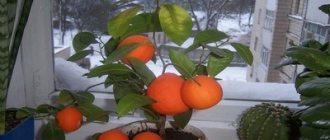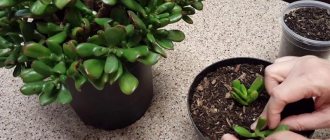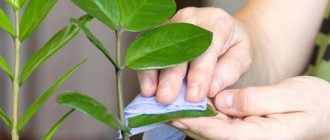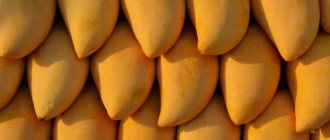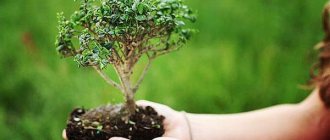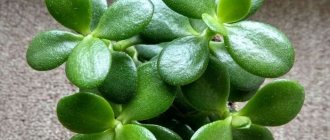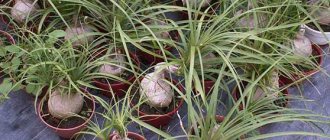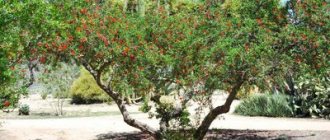History of appearance as a house plant
Orange is considered a representative of the Rutaceae family; its homeland is the eastern part of Asia. This type of citrus fruit is very popular. Its history begins 4 thousand years BC in southeast Asia.
Orange in apartment conditions
Since orange grows rather poorly in unprotected soil, glass greenhouses were equipped for its maintenance. Then they began to grow orange trees at home.
Optimal conditions
In order to obtain not just an ornamental, but a fruit-bearing plant , it is provided with conditions suitable for growth and development:
- Air humidity is not lower than 40%, optimally 80%.
- The temperature in summer and spring, at the beginning of autumn is maintained within +18…+20°C. In winter, plants feel good at +14°C.
- From mid-spring to mid-autumn, the orange tree has enough natural light. In winter, the plant is illuminated with a phytolamp so that its daylight hours are at least 7 hours.
Common varieties
Tea tree: home care and propagation methods
One of the famous domestic varieties is the Washington Navel orange. It is characterized by excellent taste. A medium-sized tree with a spreading crown and rich green foliage. The flowers are white in color, collected in small inflorescences with a pleasant smell. The fruits are round in shape with a navel at the top and are large in size. Average weight 0.5 kg. The skin of the fruit is mostly smooth or rough, and is easily separated from the fruit. The fruits ripen at the end of the year. The pulp is divided into 13 sectors by partitions of medium thickness and contains a large percentage of juice. This type of culture is propagated by cuttings, especially when moistened in growth-stimulating substances.
Pavlovsky. The description of the variety comes down to the following: it is very good for growing in apartment conditions. The tree grows up to 100 cm in height with beautiful, bright green leaves. The flowers of this variety are white, collected in bunches, with a pleasant aroma. The fruit itself is round, bright orange in color. The crop is propagated using cuttings in late winter and early spring.
Trimming / Support / Garter
Indoor oranges are pruned in the spring before active growth begins. If the tree is not pruned, it will not look beautiful, and the appearance of flowers and fruits will be delayed.
Flowers are formed on orange branches of the 5th order and higher . This means that until the branched crown of the tree is formed, it will not bloom. Therefore, the top of an orange seedling is shortened at a height of about 20 cm. After this, the growth of lateral shoots of the 1st order begins.
In a young orange, leave 4-5 of the strongest branches of the 1st order, shorten them to a length of 20-25 cm, and cut out the remaining shoots.
Branches of the 2nd order, which grow from the main skeletal branches, are shortened to a length of 25 cm. Shoots of the 3rd and 4th orders are shortened by 5 cm.
This completes the formative pruning. Every year you need to cut out weak shoots and extra branches . The branches themselves must be pruned to give the crown a certain shape.
Features of orange care
How to propagate a dollar tree at home
This tropical resident likes warm air, so it is best to keep it in rooms located in the southern part of the apartment. Homemade orange is very demanding of the crops around it.
Important! Citrus does not tolerate monstera, hibiscus, ficus with large leaves, or cucumber seedlings in the immediate environment.
Lighting
Orange at home loves good lighting. Therefore, the pot with it must be placed where there is no lack of light, and additional lighting must be provided.
Important! The tree should not be exposed to direct ultraviolet rays, as it can burn the foliage.
Temperature
The most acceptable temperature is considered to be from +24 to +26 °C in summer and not lower than +12 °C in winter. In very hot weather, the flowers begin to dry out and fall off, and the tree itself stops growing.
Important! It is characteristic of the orange that when kept indoors it has no rest time. If in winter it is placed on a balcony or in a special greenhouse, then it goes to sleep, and minimal conditions for keeping it at this time are required.
Watering
Good watering has a positive effect on the orange, so do not allow the soil to become too dry. The watering time is determined as follows: you need to pick up a piece of soil at a depth of 4-9 cm and try to roll it into a ball; if this fails, you should water it.
In summer, the crop is watered every day, in winter once a week. Water with settled, warm water.
Spraying and humidity
Orange has a positive attitude towards the greenhouse effect. The air humidity level acceptable for it is at least 85%. Spraying must be done several times a day.
Feeding
When applying fertilizers, the main thing is not to overdo it. There should be a balance in the necessary substances. It is recommended to purchase ready-made ones.
Priming
Oranges are very picky about soil, so choosing the right one for them is not so easy. Currently, you can purchase many different substrates for such crops. Such soil already includes all the required nutrients and vitamins.
Reproduction methods
Cuttings
An important advantage of the method is the preservation of varietal characteristics. To obtain cuttings, use branches from this and last year that are covered with bark. Using a sharp knife, cut a cutting 8-10 cm long with 5 leaves immediately below the bud at the bottom and 5 mm above the bud at the top. Remove the leaf from the bottom bud. Plant the finished cuttings in a mini-greenhouse in sandy soil. Place the greenhouse in a bright place without direct sunlight and keep the soil slightly moist. After about a month, the rooted cuttings can be transplanted into an individual pot. Do this carefully so as not to damage the delicate roots.
Planting seeds
Even a novice gardener can use this method. Plants grown from seeds are less demanding of care, grow quickly, but begin to bear fruit only at 8-15 years of age. Be aware that such a tree may not borrow the varietal characteristics of the parent. Use seeds for planting from indoor oranges. Store-bought fruit seeds are not suitable for growing indoors.
The seeds must be fresh, that is, just taken out. They need to be planted in a mixture of humus and sand to a depth of 1 cm. Cover the container with film and place in a dark place. With moderate watering, the first shoots will appear in about a month. When the first two leaves grow, transplant the sprout into a pot.
Graft
It allows you to get a faster harvest, so the scion should be taken from a fruit-bearing tree. The disadvantage of this method is that it can only be used during the period of active sap flow. Use a razor-sharp knife to cut the cuttings. You can graft onto a lemon or orange tree that is 2-3 years old. Cut off its crown at a height of 10 cm from the ground. Split the trunk into two halves and insert the cutting with oblique cuts. Choose a scion with 3 buds. Align the two branches and wrap the grafting site with film. To retain moisture, cover the plant with film and place it in a bright place. After about 3 weeks it will be clear whether the cutting has taken root or not. If it doesn't turn black, then everything worked out.
Many housewives are faced with yellowing of foliage. Sometimes an orange can shed its crown completely. Watch the tree. Perhaps you overdid it with watering or fertilizing. Either your orange does not have enough light or is in a draft.
When and how does an orange bloom?
It has bisexual flowers, quite large, up to 50 mm in size. The flower consists of five petals, white in color, but also with a reddish tint.
Types and forms of flowers
The flowers are collected in inflorescences in the form of a brush of several pieces. There are also single flowers, but they are rare.
Flowering period
Orange flowers usually appear in spring. Some domestic varieties bloom year-round.
How to care for an orange during flowering
In order for the crop to bloom normally, it is necessary to create certain conditions indoors. The buds that form in the spring bloom at temperatures from +17 to +19 °C degrees.
Orange blossom
Growing from seeds
The seeds are removed from the ripe orange and inspected for blemishes. For successful germination of seeds, they must be dried, but before that they are washed under running water and cleared of pulp. Next, the seeds are soaked in a small glass containing warm water overnight.
The seeds are laid out on a damp paper towel and covered with it, then the towel is placed in a sealed zip bag, which should be kept at a temperature of 22 to 24 ° C. The paper is periodically moistened, because The seeds must not be allowed to dry out. After about two weeks, the latter ripen and are transplanted into sterile soil for germination and rooting. Replant carefully to successfully root the young shoot.
How to propagate an orange yourself
Culture propagation is usually carried out in three ways: grafting, cuttings, layering and seeds. At home, the most common method of propagation is the use of cuttings. This method makes it possible to obtain fruit-bearing trees within 5 years.
Rooting cuttings
Cuttings are taken from a healthy tree; they should have several normally developing buds. Cuttings are rooted using a container with soil, but this can be done simply in water. Rooting occurs within half a month.
Cuttings
Graft
Vaccinations are carried out in the spring, during the period of intensive growth and sap flow. Cuttings undamaged by disease are used. Do not file down the grafting site, but cut it evenly. Connect the scion and rootstock so that their cambial layers coincide. To do this, the cutting diameter must be equal in size. Now press the branches as hard as possible and wrap them with material. The grafting site must be wrapped in polyethylene to create conditions of high humidity.
Layerings
Reproduction is carried out as follows: from a crop characterized by good fruiting, the best and healthiest branch is selected, the length of which is up to 0.3 m, thickness 60 mm. At a distance of 100 mm from the bottom edge, two annular cuts are made, with a distance of 120 mm between them. The cut bark is removed. All foliage that is located 50 mm above and below this place is removed.
A light plastic container is cut in half and hung from a branch so that the cut falls on the center of the container. Now the two halves of the container are tied together and filled with washed sand or moss, previously treated with steam. The filling should not be dry, so it is watered with warm water. After 2-3 months, you can cut the branch and plant it together with the substrate in a container with a diameter of at least 13 cm. The cut is powdered with charcoal. After planting, the container with the layering is placed in a shaded room and constantly sprayed.
Seeds
Planting material is best taken from ripe fruit.
Important! The seeds should not be small.
The selected planting material must be prepared for planting:
- remove any remaining pulp and rinse with settled water;
- Soak for a day in water where fertilizers are diluted.
Plant the seeds in a separate container with a capacity of at least 0.1 liters. You can use yogurt jars, you need to make holes in them to drain excess moisture and ensure good drainage. Seeds are planted at least 10 mm deep. The soil can be purchased ready-made, or you can make it yourself in 1 to 1 proportions of garden soil and peat.
Propagation by seeds
Orange tree
If you want to get a harvest faster, it is better to graft or propagate the orange using cuttings. After grafting or after planting a cutting, the plant can bloom in 3-4 years.
Conditions for germinating orange seeds
In order to grow a seedling, you must follow the following step-by-step procedure:
- Preparation of seed material;
- Preparation of soil and containers for growing seedlings;
- Replanting seeds;
- Sowing care;
- Picking and transplanting a finished seedling.
It is better to plant an orange in early spring so that there is sufficient natural light for the seedlings.
How to choose a fruit of the desired maturity and separate the stone
To obtain seeds, you need to take fully ripened fruits, without damage or rot. Ripe oranges have a rich, specific smell and are heavy in weight. The fruit should be evenly colored and free of spots.
The most round, large and full-bodied seeds are selected. They are immediately freed from pulp, washed in water and soaked for 12-24 hours in water or a solution of Epin or another growth stimulant. Soaking will soften the outer shell of the seeds, which will allow the seeds to germinate faster.
Attention! Dried seeds are not used for germination, as the thick skin will prevent germination
Preparing the soil mixture and choosing a pot
Soil for planting can be purchased at the store, or you can make it yourself. To prepare the soil mixture, use leaf soil, sand and peat, taken in equal quantities, or leaf soil and peat. For sowing, you can use small containers with drainage holes.
A drainage layer of expanded clay, vermiculite, etc. is placed at the bottom of the pot. Soil is poured on top and compacted a little.
Planting and growing seedlings
The seed needs to be planted shallowly, to a depth of 1-1.5 cm. The prepared pots are placed in a warm place. Lighting does not play a role at this stage. To create a greenhouse effect, they are covered on top with a piece of polyethylene or a cut plastic bottle.
You can pre-germinate the seeds. To do this, place a cloth in the container, which is pre-moistened. Seeds are placed on it, which is also covered with a damp cloth. They are setting up a greenhouse. After a few weeks, the seeds will germinate. After germination, the seedlings are transferred to a well-lit place.
When 2 leaves appear, the seedlings need to be picked; when 4 leaves appear, they are transplanted by transshipment to a permanent place.
Possible problems with orange cultivation
When growing orange indoors, certain problems may arise:
- The tips of the leaves dry out. This is due to insufficient nutrients. Especially Fe, N. deficiency of the first element leads to yellowing of the veins, of the second to yellowing of the entire leaf as a whole. To eliminate the problem, the crop needs to be fed with fertilizers containing iron. Nitrogen fertilizers should be fed to the crop in the spring.
- Pests. Orange is susceptible to harmful insects that cause damage to the leaves, usually worms and spider mites. You can fight them by constantly washing the crop with water, as well as using insecticides.
Mature tree with fruits
- Diseases. Among them, spotted chlorosis is the most common; it is spread by insects and causes the areas of leaves between the veins to turn yellow. To combat this disease, you simply need to destroy the damaged areas.
- Exposure to low temperatures. The lowest temperature that an orange can withstand is +2 degrees, so you need to protect the crop from exposure to negative temperatures.
- The crop drops buds, this may be due to too high a temperature, insufficient watering, and excessive fertilization. To eliminate the problem, you need to create the appropriate conditions.
- The leaves turn pale and fall off. The problem may be due to root rot. It is necessary to check the root system and eliminate damaged roots.
Thus, growing oranges is not at all difficult; you just need to create the necessary conditions for the culture.
Diseases
Oranges are susceptible to many fungal diseases. But it is usually weak plants that are poorly cared for that get sick. The most common fungal diseases are root rot, sooty fungus, scab and warts.
Root rot occurs due to excessive soil moisture and stagnation of water in the pot. The disease develops unnoticed until the plant begins to rapidly lose leaves. The tree can only be saved by transplanting it into a new substrate. Rotten roots must be removed.
Sooty fungus appears on leaves and branches in the form of a black coating. It can be dealt with by removing plaque and ventilating the room. It is also necessary to reduce the intensity of watering.
Dark bumps form on the leaves of oranges affected by scab . Leaves fall and the bark on affected branches cracks.
To combat the disease, copper sulfate, Bordeaux mixture and other fungicides are used. Spraying is carried out in the spring and after flowering. Diseased leaves and branches are cut off and burned.
Wart is a fungal disease in which growths form on the shoots of a tree and gray warts on its leaves. Sick branches die. To combat the disease, Bordeaux mixture is used, which is sprayed onto the crown after wintering, after flowering and in mid-summer.
Orange trees are affected by almost all known pests of indoor plants. Plants suffer most from scale insects. If pests are detected, the plant must be immediately sprayed with insecticides.
Basic mistakes
When growing an orange from a seed, the most fatal mistakes are:
- using dry seeds: they may not sprout;
- deepening of the root collar during transplantation: fraught with slow growth, and in severe cases, the death of the plant;
- insufficient lighting: the tree will grow slowly and may never bloom;
- excessively dry air: in such conditions, oranges often shed their leaves;
- waterlogging of the soil: the result can be rotting of the root system, requiring urgent replanting with removal of damaged roots.
Trying to grow an orange without grafting can also be called a mistake: in this case, flowering may not occur very soon, and the fruits may turn out to be small and tasteless.
Growing an orange from a seed is an interesting activity, accessible even to a schoolchild. Getting seedlings is not a problem, growing a tree is not a problem either. But to try the grown fruits, you will have to not only try, but also be patient.
Useful tips on the topic
Advice from experienced gardeners will help make it easier to grow oranges and get a rich harvest :
- If in winter the plant is left at a temperature below +10°C , watered 1-2 times a month and not fed, then in the spring, when care resumes, it will grow faster. This will speed up the appearance of fruits.
- plants are also grafted onto oranges
- Yellowing of the leaves indicates a lack or excess of watering , lack of fertilizer or exposure to drafts on the plant.
- To reduce the risk of infection of an orange and improve its photosynthesis, once a week the leaves are wiped of dust with a damp cloth.
- Plants affected by insects are washed in a shower at room temperature.
